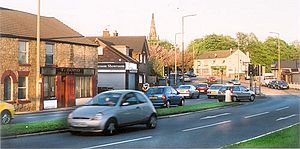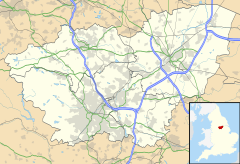Handsworth, South Yorkshire facts for kids
Quick facts for kids Handsworth |
|
|---|---|
 Handsworth, looking east |
|
| Population | 9,957 |
| OS grid reference | SK416861 |
| Metropolitan borough | |
| Metropolitan county | |
| Region | |
| Country | England |
| Sovereign state | United Kingdom |
| Post town | SHEFFIELD |
| Postcode district | S13 |
| Dialling code | 0114 |
| Police | South Yorkshire |
| Fire | South Yorkshire |
| Ambulance | Yorkshire |
| EU Parliament | Yorkshire and the Humber |
| UK Parliament |
|
Handsworth is a cool suburb in south eastern Sheffield, England. It's located in South Yorkshire. This area is about 5 square miles big. Around 9,957 people call Handsworth home.
You'll find five schools and four churches here. There are also many small shops and a big supermarket. Handsworth has lots of different businesses too. Before 1974, it was part of the West Riding of Yorkshire. Today, Handsworth is part of the Woodhouse area. This is for local government. It's also in the Sheffield South East voting area.
Contents
Handsworth's Past: A Look Back
Handsworth used to be its own 'parish'. This is a type of local area. In 1931, it had over 17,000 people. On April 1, 1938, Handsworth joined with Sheffield. It also merged with Orgreave. Now, it's part of Sheffield.
Handsworth in the Domesday Book
The Domesday Book is a very old record. It was made in 1086. In this book, Handsworth is called "Handeswrde". It was linked with Whiston as one big area. Before the Norman Conquest, a person named Torchil was the local lord. After the Conquest, Robert, Count of Mortain took over. He was the half-brother of William the Conqueror.
Later, the land passed to the Paynel and Lovetot families. A member of the Lovetot family built the main church in Handsworth.
St Mary's Church: A Historic Building
St Mary's Church was built around 1170. It was started by a Norman lord. His name was William de Lovetot. Or maybe his father, Richard, started it. William Paynel helped plan the church's foundations. This church is not the same as the one in Birmingham.
Not much of the old Tudor rectory is left today. The church's records are very old. They go back to 1558. This was the year Queen Elizabeth I became queen. These records show all the baptisms, marriages, and burials. They happened in the St Mary's parish.
The St Mary's Parish Centre has cool displays. You can see old items and documents there. There are also records, photos, and maps. All of these tell the story of Handsworth.
Handsworth Sword Dancers: A Living Tradition
One special part of Handsworth's history is still alive. It's the traditional sword dancing. No one knows exactly when this dance started. But written records go back to the mid-1800s.
Eight men perform this dance. They use long steel swords. The dance lasts about nine minutes. It ends with all the swords locked together. One man holds them up high. Traditional music plays along. The dancers wear uniforms. They look like old military uniforms.
Long ago, there were two clowns. They would perform for the crowd. They also collected money. Around Christmas, the dancers would visit local villages. They also went to pubs. The sword dancing stopped during the First World War. But it came back in the late 1920s. It even continued through the Second World War. This was because the dancers worked in coal mines and steel works. These were important jobs. So, they were not sent to fight.
The traditional dancing on Boxing Day started again in 1963. This happens in Handsworth and Woodhouse. In 1976, the clowns returned. But they stopped again later. You can still see the Handsworth sword dancers today. They perform on Boxing Day. If Boxing Day is a Sunday, they dance the next day. They dance at Woodhouse Cross at 11:15 AM. Then they dance in front of St Mary's Church at noon. After that, the dancers and audience go to a pub. They enjoy drinks and sing carols together.
Sports Teams in Handsworth
Handsworth has had three important football teams. They played in senior leagues.
- Handsworth F.C. – This team played in the 1921–22 FA Cup. We don't know much more about them.
- Handsworth F.C. – This team started in 2003. They played in the Sheffield and Hallamshire County Senior Football League. After seven years, they moved up to the Northern Counties East League. They played there for two years. Then they went back down. Their home ground wasn't good enough for the higher league. In 2014, they won the County Senior League. Then they joined with Parramore Sports F.C. to form a new team.
- Handsworth Parramore F.C. – This team formed in 2014. It was a merger of the two teams above. They joined the Northern Counties East League Premier Division. They also played in the FA Cup for the first time. In 2019, they changed their name back to Handsworth F.C..
Famous People from Handsworth
Many interesting people have connections to Handsworth.
The Stayce Family
The old church records show a boy named Mahlon Stayce. He was baptized at St Mary's Church in 1638. The Stayce family lived in Handsworth for a long time. They lived at Ballifield Hall. But Mahlon became famous in America. He made his money in Trenton, New Jersey.
The Stayce family were Quakers. This was a new religious group. They appeared after the English Civil War. Quakers had different ideas from others. Some people thought they were extreme. Their leader, George Fox, spoke in Handsworth in the 1650s. Thousands of people came to listen. During that time, Quakers were not trusted. They were treated badly. This continued even after King Charles II returned to power. Quakers refused to follow the Church of England. They also refused to take off their hats. And they wouldn't speak "respectfully" to nobles. This made people distrust them even more.
Some of the Stayce family are buried in a private Quaker graveyard. It's at Cinder Hill. There are eight simple gravestones there.
Benjamin Huntsman: Steel Innovator
Benjamin Huntsman was another Quaker. He is buried near Handsworth. He was born in Lincolnshire. But he lived in Handsworth in the 1740s. Huntsman made a huge scientific discovery. It helped Sheffield grow. Sheffield became a major industrial city. It shaped Britain's future.
Huntsman changed how steel was made. He invented "cast" or "crucible steel". While in Handsworth, he found a way to melt raw steel. He could then make solid blocks of steel. This needed a very high heat. It was 1,600 degrees Celsius. No one had reached this temperature in steel making before. To get this heat, Huntsman used coke. This is a type of fuel. He used it instead of charcoal. He also designed a special clay pot. This pot could handle the extreme heat. It also protected the metal.
Huntsman likely moved to Handsworth for a reason. He knew about the glassworks in Catcliffe. They used special pots to melt materials at high heat. Handsworth also had good clay. This clay was needed for his pots.
At first, people in Sheffield didn't like Huntsman's new steel. Local cutlers thought it was too hard. But other countries, like France, quickly used it. This competition made Sheffield cutlers adopt Huntsman's methods. This helped build Sheffield's industrial history. In 1740, Sheffield made only 200 tons of steel a year. By 1860, it made over 80,000 tons. This was almost half of Europe's total steel!
William Jeffcock: Sheffield's First Mayor
William Jeffcock was born in Handsworth in April 1800. He became the first Mayor of Sheffield in 1843. His baptism is in the Handsworth church records. He died in Ireland, but he is buried in Handsworth.
The Jeffcock family moved to Handsworth in the 1600s. They came from Eckington. The family name first appears in records from 1351. But they settled in Handsworth. There are over 60 entries for the Jeffcock family in the church records. These are from 1636 to 1768. William's father, John Jeffcock, was a coal master. He was an engineer at Dore House Colliery in Handsworth. William built on his father's success. He became involved in local government.
William wanted to help with city matters. So, he ran for election in 1843. He was elected to the new town council. On November 9, 1843, the council met. They all chose William Jeffcock to be the first mayor. He was also an Alderman. He stayed on the council for 10 years. In 1846, he became a Justice of the Peace. He also served in the West Yorkshire Yeomanry Cavalry.
For many years, the Jeffcocks lived in High Hazels. John Jeffcock was the first to live there. But William built a new mansion there in 1850. You can see how close the Jeffcock family was to Handsworth. There are two tombs in St Mary's churchyard. They remember over a dozen Jeffcocks. There are other memorials inside the church. And there's an old fountain on Handsworth Road. It also has inscriptions about the family.
Thomas Dunn: Another Mayor from Handsworth
Thomas Dunn was William Jeffcock's first cousin. He also lived in Handsworth. Dunn became Sheffield's Mayor in 1844. He was elected to the first town council in 1843. He served for 16 years. Dunn was an Alderman. He became a very important person in Sheffield. He had a Liberal viewpoint. He played a big role in Sheffield politics. Many people wanted him to run for Parliament. His funeral in 1871 was attended by many important local people.
Percy "Pick" Pickard: War Hero
Group Captain Percy Charles "Pick" Pickard was a Royal Air Force pilot. He was a commander during the Second World War. He was born in Handsworth in 1915. He went to Framlingham College. People remember him from a 1941 war film. It was called Target for Tonight. He was the pilot of "F-Freddie" in the film. He died in 1944 during a mission called Operation Jericho. His sister, Helena Pickard, was also born in Handsworth. She was an actress. She married actor Sir Cedric Hardwicke. Their son was actor Edward Hardwicke.
Sean Bean: Famous Actor
Actor Sean Bean was born in 1959. He grew up in Handsworth. He went to Brook School there. That school is now a housing estate. Sean Bean has been in many famous movies. These include The Lord of the Rings, Patriot Games, and GoldenEye. He also starred in the TV series Sharpe. And he was in the worldwide hit Game of Thrones.




